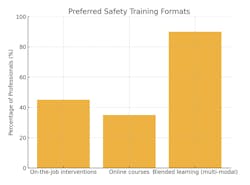Throughout the first half of 2024, EHS Today partnered with SafetyNow to produce the 2024 State of Safety Training Survey, which offers a revealing look into the challenges and opportunities shaping workplace safety today. With input from over 5,000 safety professionals and responses from a massive outreach to more than 400,000 individuals, the findings give practical direction for anyone looking to elevate their safety programs.
Here are the key takeaways—and what they mean for you.
The Future of Safety Training is Blended
If you’re still relying solely on traditional classroom-style safety training, it’s time to rethink your approach. Over 90% of surveyed professionals agree that blended learning—mixing live sessions, online courses, videos, and other tools—makes training more engaging and effective (Figure 1). E-learning, in particular, has exploded in popularity, growing by 350% since 2019.
This shift isn’t just about convenience; it’s about delivering results. Training that combines different methods improves comprehension and retention, ensuring employees not only stay safe but also fully understand what’s expected of them.
How to make this actionable:
- Incorporate online learning tools and interactive videos into your current training regimen.
- Leverage industry-specific content with modern visuals to keep employees engaged.
Tackling Common Safety Training Roadblocks
What’s holding safety programs back? The survey highlighted three major pain points (Figure 2):
- Employee Engagement: Let’s face it—keeping safety training interesting is no easy task. But it’s essential.
- Resource Gaps: Finding fresh, relevant content can be a struggle, especially in niche industries.
- Management Buy-In: Selling the value of safety training to executives is often the difference between a fully funded program and one that struggles to meet its goals.
The good news? Companies with proactive, well-structured training programs are seeing real results. Respondents reported workplace incident rates that were 74% lower than the industry average—a compelling case for investing time and resources in your safety strategy.
Quick wins for you:
- Plan safety training topics at least a quarter in advance to stay proactive.
- Use data, such as reduced incident rates or workers’ comp savings, to make the case for budget and resources.
Technology is Driving the Next Wave of Safety Training
Want to future-proof your program? Go digital. The survey shows a clear trend toward online and mobile platforms that make training accessible anytime, anywhere. Flexible, adaptive systems that let you tailor training to specific roles, risks, or locations are becoming the gold standard. Real-time compliance tracking and analytics tools are also on the rise, helping organizations make smarter, faster decisions.
Generative AI is transforming workplace safety training by making it smarter, more engaging and tailored to your team’s needs. Imagine giving your employees access to realistic, AI-generated simulations where they can practice responding to hazards without any real-world risk. Or using AI to personalize training content for specific roles, job sites, or risks—so your forklift operator gets training relevant to their daily tasks, not generic safety lessons.
AI can even analyze past incidents to predict risks and suggest proactive training modules to prevent accidents before they happen. Need quick answers to safety questions? AI-powered assistants can provide real-time guidance, reinforcing best practices on the spot. By integrating these tools, you’re not just training your team—you’re building a culture of safety that’s dynamic, effective and future-ready.
Here’s how you can start:
- Explore mobile-friendly training platforms for your workforce.
- Use learning management systems (LMS) to create customized, scalable safety plans that grow with your organization.
- Explore and maybe implement some of the new and accessible AI chatbots to quickly and inexpensively create highly custom and compliant training that engages.
Building a Stronger Safety Culture
Safety isn’t just about reducing incidents—it’s about building a culture where everyone feels invested in staying safe. Companies that prioritize regular safety meetings, blended training formats, and forward-thinking tools are seeing big improvements in morale, compliance and overall efficiency.
Take the next step:
- Schedule daily or weekly safety huddles to reinforce key practices.
- Make safety training part of your organization’s DNA by integrating it into everyday operations.
The findings from this survey are more than just statistics—they’re a roadmap for creating safer, smarter workplaces. Whether you’re just starting to modernize your safety training or looking to fine-tune an existing program, these insights can help you take meaningful, actionable steps forward.
To find out more about the 2024 State of Safety Training Survey, or to get access to a pilot program of SafetyNow’s online training, LMS and AI-enabled tools, go to www.safetynow.com/lms-25-off/. All readers instantly get 25% off.


